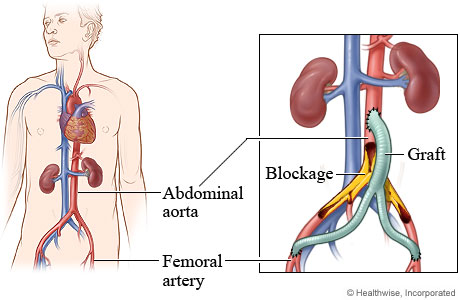Aortobifemoral Bypass Surgery
Surgery Overview
An aortobifemoral bypass is surgery to move blood flow around narrowed or blocked blood vessels in your belly or groin area. This will increase blood flow to your legs. This may relieve symptoms such as leg pain, numbness, and cramping. You may be able to walk longer distances without leg pain.
The doctor will use a graft to bypass the narrowed or blocked blood vessels. The graft is made of human-made material. The graft will carry blood from the aorta to the femoral artery. This artery is in the groin area of each thigh. The aorta is the large blood vessel that carries blood from the heart to the blood vessels in the belly. The femoral arteries are large blood vessels that carry blood from the blood vessels in the belly to the legs.
You will probably be asleep during this surgery. The doctor will make a cut in your belly. The doctor will also make a cut in your groin at the top of each thigh. These cuts are called incisions. The doctor will put the graft in through the incisions. The graft is connected to the aorta and the femoral arteries. Stitches or staples are used to close the incisions.
You may spend at least several days in the hospital. You will need to take it easy for at least 4 to 6 weeks at home.
How It Is Done

Aortobifemoral bypass surgery is used to bypass a narrowed or blocked part of the large blood vessels in the abdomen and groin.
To bypass the diseased part of the blood vessel, blood is redirected through a graft. The graft is made of human-made material. This graft is sewn above and below the diseased vessel so that blood flows through the graft and around the narrowed or blocked part. The graft looks like an upside-down Y shape. The single end of the Y is sewn on the aorta. The two split ends of the Y are sewn below the blocked or narrowed areas of the femoral arteries.
What To Expect
You may spend several days in the hospital. Your belly and groin will be sore for several weeks. You will probably feel more tired than usual for several weeks.
You may be able to do many of your usual activities after 4 to 6 weeks. But you will likely need 2 to 3 months to fully recover.
You may need to take at least 4 to 6 weeks off from work. It depends on the type of work you do and how you feel.
You will have regular tests to check for problems with the graft.
Why It Is Done
Aortobifemoral bypass surgery is for people who have narrowed or blocked blood vessels (aorta or iliac arteries) in the abdomen and pelvis. Usually the disease must be causing significant symptoms or be limb-threatening before bypass surgery is considered.
Learn more
Risks
All surgeries carry a certain amount of risk. These risks include:
- Infection.
- Bleeding.
- Heart attack or stroke.
Specific risks for aortobifemoral bypass surgery include:
- Leg swelling.
- Failed or blocked grafts.
- Kidney problems.
References
Citations
-
Conte MS, et al. (2019). Global vascular guidelines on the management of chronic limb-threatening ischemia. Journal of Vascular Surgery, 69(6S): 3S–125S.e40. DOI: 10.1016/j.jvs.2019.02.016. Accessed June 1, 2023.
-
Gerhard-Herman MD, et al. (2016). 2016 AHA/ACC guideline on the management of patients with lower extremity peripheral artery disease. Circulation, published online November 13, 2016. DOI: 10.1161/CIR.0000000000000471. Accessed November 25, 2016.
-
Conte M, et al. (2015). Society for Vascular Surgery practice guidelines for atherosclerotic occlusive disease of the lower extremities: Management of asymptomatic disease and claudication. Journal of Vascular Surgery, 61(3S): 2S–41S. DOI: 10.1016/j.jvs.2014.12.009. Accessed November 25, 2016.
Credits
Current as of: October 2, 2025
Current as of: October 2, 2025
Conte MS, et al. (2019). Global vascular guidelines on the management of chronic limb-threatening ischemia. Journal of Vascular Surgery, 69(6S): 3S–125S.e40. DOI: 10.1016/j.jvs.2019.02.016. Accessed June 1, 2023.
Gerhard-Herman MD, et al. (2016). 2016 AHA/ACC guideline on the management of patients with lower extremity peripheral artery disease. Circulation, published online November 13, 2016. DOI: 10.1161/CIR.0000000000000471. Accessed November 25, 2016.
Conte M, et al. (2015). Society for Vascular Surgery practice guidelines for atherosclerotic occlusive disease of the lower extremities: Management of asymptomatic disease and claudication. Journal of Vascular Surgery, 61(3S): 2S–41S. DOI: 10.1016/j.jvs.2014.12.009. Accessed November 25, 2016.